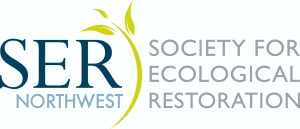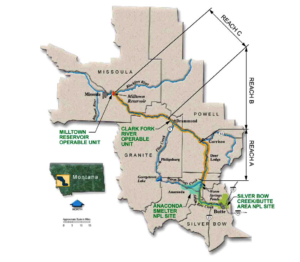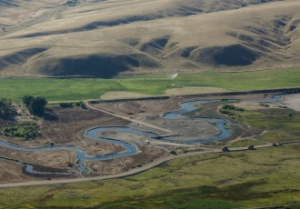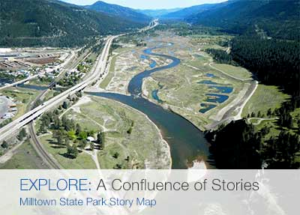An Introduction to Restoration in Western Montana
By Dan Spencer, Professor of Environmental Studies, University of Montana; SER Board Member 2015-2018
Twelve years ago in 2006 I began teaching what has become an annual class at the University of Montana: “Ethical Issues in Ecological Restoration.” With my background in geology, ethics, philosophy and theology, and my long-time interest in restoration, I was keen to use the western Montana context for exploring different ethical and philosophical issues in the array of restoration efforts ongoing in the northern Rocky Mountains. Hence this introduction to restoration in western Montana is shaped largely by my experience working with government, academic and nonprofit partners in restoration in diverse contexts throughout the region.
The ongoing multi-year, multi-million dollar remediation and restoration of the Upper Clark Fork River is arguably the centerpiece of much of the restoration taking place in western Montana. Catastrophic flooding in 1908 washed tons of toxic mine tailings from the Butte mines and Anaconda smelters at the headwaters of the Clark Fork River into the watershed, contaminating the upper 115 miles of the river until much of the sediments were impounded behind the recently built Milltown Dam five miles upstream from Missoula (see map). In 2008, 25 years after the state sued Atlantic-Richfield (now owned by BP) for damages, the EPA issued its consent decree and remediation and restoration work on the Upper Clark Fork began.
source: http://www.buttectec.org/
With the MT Department of Environmental Quality (DEQ) as the lead agent, the EPA and DEQ are removing contaminated sediments from the upper 43 miles of the Upper Clark Fork, and restoring the river. The Clark Fork Coalition has worked with the state and the ranching community along the river to build partnerships in the restoration work (see accompanying article by Will McDowell for more on this). Central to this effort was the CFC’s 2005 purchase of the Dry Cottonwood Creek Ranch in the upper Clark Fork to serve as a pilot project for an active cattle ranch going through the cleanup and restoration process. For the past 12 years my class has carried out annual restoration-related projects on the DCCR and watched the full-scale remediation and restoration of the 3 miles of the Clark Fork that runs through the ranch in the past two years.
Restoration on the Dry Cottonwood Creek Ranch. Source: https://clarkfork.org/superfund-cleanup-its-working/
Further downstream, the impounded mine tailings behind the Milltown Dam were removed over a two year process that culminated in the March 2010 removal of the Milltown Dam. This reconnected the confluence of the Blackfoot and Clark Fork Rivers and restored fish connectivity to the Upper Clark Fork for the first time in a century. With the establishment of the Milltown Dam Park active restoration of the confluence lands began, with thousands of hours of professional and volunteer restoration work under way.
Source: http://stateparks.mt.gov/export/sites/ParksPublic/milltown/exploreConfluence400.jpg
A distinctive feature of this restoration work has been building partnerships with the ranching community whose lands contain over 90% of the Clark Fork River. Interested ranchers banded together in 1999 to form the Watershed Restoration Coalition which has been instrumental in carrying out numerous stream and upland restoration projects in tributary streams, restoring connectivity to the main stem of the Clark Fork. My restoration class has worked with several ranchers in class projects, especially the Thomas Hereford Ranch on Gold Creek, whose owner Bruce Thomas serves on the board of the WRC. Involving the ranching and university communities with both NGOs and state agencies working in restoration has built promising partnerships to carry out and sustain restoration work in the upper Clark Fork River watershed.
Riparian restoration project on Gold Creek, Thomas Ranch, October 2008 (Photo: Dan Spencer)
Restoration work in the Upper Clark Fork includes mine land reclamation and remediation of both former mine sites in Butte and lands in the Anaconda uplands contaminated by decades of toxic fumes from the Anaconda smelter. Pedro Marques, restoration manager for the Big Hole Watershed Committee, has been working to remediate and restore the highly contaminated and eroded Anaconda uplands through building hundreds of beaver dam analogs (BDAs) to reconnect deeply incised streams to their historic floodplains.
One of the most innovative restoration projects in the Clark Fork watershed is the Confederated Salish and Kootenai Tribes’ restoration of the Jocko River. The tribes are integrating this long-term restoration project to cultural education and restoration, developing an innovative Explore the River curriculum that integrates ecological and cultural restoration into schools across the Flathead Reservation.
The Restoration Ecology Lab in the Ecosystem Science and Restoration program at the University of Montana prepares students to do a wide range of restoration projects under the tutelage professors Cara Nelson (former chair of the SER Board) and Lisa Eby. Cara also advises the UM-SER chapter which has carried out numerous terrestrial and riparian restoration projects. Currently several students are carrying out projects in the Rock Creek Confluence restoration, one of many restoration projects being managed by Five Valleys Land Trust.
Forest restoration is also a major focus of many restoration groups in western Montana, including the work of The Nature Conservancy and local organizations such as The Blackfoot Challenge. The Montana Department of Natural Resources and Conservation has a program, “Focused on Forest Restoration,” that has authorized 16 projects on state, private, and tribal lands totaling 4,240 acres in nine Montana counties. And the Montana chapter of Trout Unlimited is carrying out an ambitious, multi-year restoration of abandoned mines in the Ninemile Valley west of Missoula.
This is just a small sample of the range of restoration work being done in Montana. It is a vibrant scene and a great place to do restoration. Come join us in a project!





